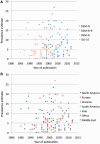ADHD prevalence estimates across three decades: an updated systematic review and meta-regression analysis
- PMID: 24464188
- PMCID: PMC4817588
- DOI: 10.1093/ije/dyt261
ADHD prevalence estimates across three decades: an updated systematic review and meta-regression analysis
Abstract
Background: Previous studies have identified significant variability in attention-deficit / hyperactivity disorder (ADHD) prevalence estimates worldwide, largely explained by methodological procedures. However, increasing rates of ADHD diagnosis and treatment throughout the past few decades have fuelled concerns about whether the true prevalence of the disorder has increased over time.
Methods: We updated the two most comprehensive systematic reviews on ADHD prevalence available in the literature. Meta-regression analyses were conducted to test the effect of year of study in the context of both methodological variables that determined variability in ADHD prevalence (diagnostic criteria, impairment criterion and source of information), and the geographical location of studies.
Results: We identified 154 original studies and included 135 in the multivariate analysis. Methodological procedures investigated were significantly associated with heterogeneity of studies. Geographical location and year of study were not associated with variability in ADHD prevalence estimates.
Conclusions: Confirming previous findings, variability in ADHD prevalence estimates is mostly explained by methodological characteristics of the studies. In the past three decades, there has been no evidence to suggest an increase in the number of children in the community who meet criteria for ADHD when standardized diagnostic procedures are followed.
Keywords: ADHD; cross-cultural; epidemiology; methodology; prevalence; time.
Figures


References
-
- Biederman J, Faraone SV. Attention-deficit hyperactivity disorder. Lancet 2005;366:237–48. - PubMed
-
- Swanson JM, Sergeant JA, Taylor E, Sonuga-Barke EJ, Jensen PS, Cantwell DP. Attention-deficit hyperactivity disorder and hyperkinetic disorder. Lancet 1998;351:429–33. - PubMed
-
- Singh I. Beyond polemics: science and ethics of ADHD. Nat Rev Neurosci 2008;9:957–64. - PubMed
-
- Timimi S, Taylor E. ADHD is best understood as a cultural construct. Br J Psychiatry 2004;184:8–9. - PubMed
-
- Polanczyk G, de Lima MS, Horta BL, Biederman J, Rohde LA. The worldwide prevalence of ADHD: a systematic review and metaregression analysis. Am J Psychiatry 2007;164:942–48. - PubMed
Publication types
MeSH terms
Grants and funding
LinkOut - more resources
Full Text Sources
Other Literature Sources
Medical
Miscellaneous

